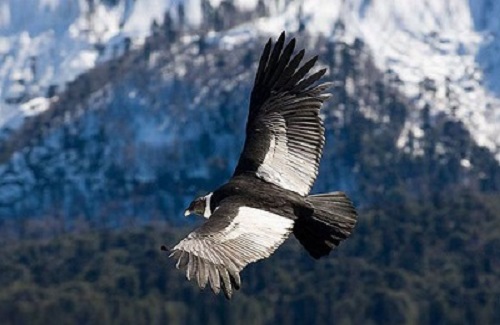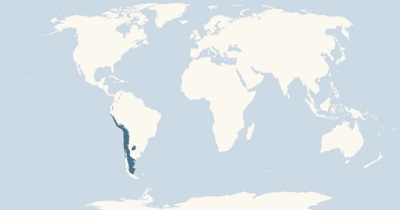0
Taxonomy

Andean condor soaring in the Andes of Peru. Source: Peru Cultural Society. The Andean condor is classified as near threatened by the IUCN Red List of Threatened Species.
- Kingdom: Animalia
- Phylum: Chordata
- Class: Aves
- Order: Cathartiformes
- Family: Cathartidae
- Genus: Vultur
- Species: Vultur gryphus
Name
- Common name: Andean condor.
- Scientific name: Vultur gryphus
0
Habitat and Distribution
- The Andean Condor (Vultus gryphus) is one of the 7 species of New World vultures found in warm and temperate areas of the American continent.
- The Andean condor inhabits high peaks of the Andes Mountains of South America at elevations of up to 16,000 ft or 5,000 m. Its habitat ranges from Colombia in the north, to Ecuador, Peru, Bolivia, Argentina and Chile in the southern end of the continent.
- They also soar over coastal regions in western South America and lowland desert areas of Peru and Chile. They live in windy areas where they can glide with minimal effort.

Andean condor distribution map. Source: Peru Cultural Society
Physical Features
- Andean condors are large vultures with a ruff of white feathers around the base of the neck. Their heads and necks are dark red and featherless and change hues depending on their emotional state.
- Like their relative, the California Condor (Gymnogyps californianus), the Andean condor has bald head which keeps their feathers clean after poking inside carcass.
- The male has a wattle on the neck and a dark red comb or fleshy crest on the head. Females lack both.
- Their plumage is black except for the white ruff of feathers around the base of its neck and patches of white on their wings, more prominent on males.
- They have a hook shaped beak they use to tear decaying meat from carcasses.
- Female Andean condors have dark red irises while males’ irises are brown.
- Females are smaller than males contrary to most species of birds of prey.
- Andean condors roost in high rock ledges and make use of thermal currents to fly. Once they reach high altitudes they do not need to flap their wings.
- They have a sharp sense of sight.
Weight and Length
- Andean condors are among the largest and heaviest birds on earth. They weigh up to 33 lbs or 15 kg. They have the longest wingspan of any raptor at 10 f or 3 m.
Diet
- Andean condors travel over 150 miles a day in search of food. They use their sense of sight to locate food.
- These birds are carnivores and feed mostly on carrion. They eat the carcasses of large dead animals playing an important role in the ecosystem by disposing decaying bodies that might bring disease.
- When flying inland they eat livestock and domestic animals. They also eat eggs and young birds.
- When Andean condors are in coastal areas they feed on dead marine animals and birds.
Social Behavior
- Andean condors change the color of the skin of their neck and head indicating changes in mood. It is a way to communicate between individuals.
- Andean condors are monogamous and it is believed that they mate for life.
- They spend most of their time soaring looking for prey.
Breeding
- These birds start breeding at 5 to 6 years of age.
- They are seasonal breeders; they breed in February or March every two years.
- The female condor will deposit one or two eggs on her nest built on inaccessible ledges of large rocks.
- Both parents take turns to incubate the eggs and they hatch after an average of 55 days. Both parents care for their young for their first year or two.
- When the young are born they are covered in gray down. They are able to fly at around 6 months and stay with their parents for 2 years.
Threats
- Andean condors have low birth rate. They have one or two offspring every two years.
- Healthy adults do not have predators but hatching are prey to predators.
- Habitat loss is one of the most important threats facing Andean condors. Their mortality results from collisions with power lines.
- Andean condors are hunted by farmers who think they might attack their livestock.
Life Expectancy
- Andean condors live up to 75 years in captivity. They do not have predators in the wild and are known to live for up 50 years.
Conservation Status
- The IUCN Red List of Threatened Species lists the Andean condor as a “Near Threatened” species.
Did you Know?
The Andean condor played an important role in Inca mythology. Today the Yawar Fiesta which dates back from the time of the Spanish conquest in the 1500s is celebrated in regions of the Andes. During this celebration a condor, representing the Indians, is tied to the back of a bull, which represents the Spaniards. The condor attacks the bull with its beak while the bull tries to desperately get rid of it. Young men chase the animal trying to show courage to their communities.
Sources:
Discover Peru – Endangered Animals of the Andes
